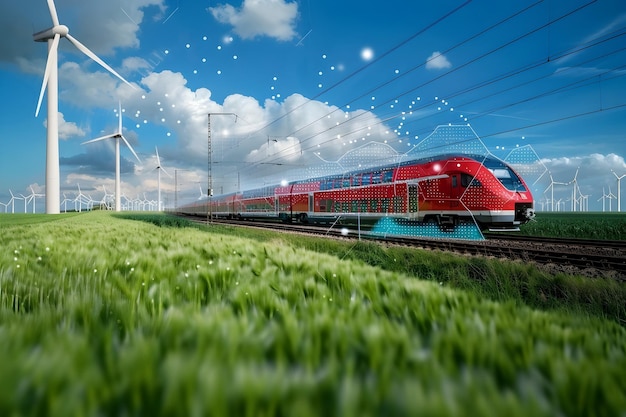The Role Of Wind Energy In Modernizing Train Networks

Table of Contents
Environmental Benefits of Wind Energy in Train Networks
The environmental case for integrating wind energy into train networks is compelling. Switching from fossil fuels to wind power offers significant improvements in air quality and drastically reduces greenhouse gas emissions.
Reduced Carbon Footprint
- Significantly reduces greenhouse gas emissions: Wind energy produces virtually no greenhouse gas emissions during operation, unlike fossil fuels which release substantial amounts of CO2, methane, and other pollutants. This shift drastically reduces the railway's carbon footprint.
- Contributes to meeting national and international climate goals: The widespread adoption of wind energy in railway systems actively supports national and international commitments to reduce carbon emissions and combat climate change, aligning with agreements like the Paris Agreement.
- Improves air quality in and around railway lines: Eliminating diesel locomotives and reducing reliance on coal-fired power plants for electricity improves air quality along railway corridors and in nearby communities, leading to better public health outcomes.
Studies have shown that replacing diesel locomotives with electric trains powered by renewable sources like wind can reduce CO2 emissions by up to 90%, significantly contributing to a cleaner environment. Meeting increasingly stringent environmental regulations and standards, such as those set by the EU or the EPA, is made significantly easier through the adoption of wind power for rail.
Sustainable Energy Source
- Wind is a readily available, inexhaustible resource: Unlike fossil fuels, which are finite and depleting, wind is a renewable resource that is constantly replenished. This ensures a long-term, sustainable energy supply for railway systems.
- Reduces dependence on finite fossil fuels: Transitioning to wind energy reduces reliance on volatile global fossil fuel markets, increasing energy security and reducing vulnerability to price fluctuations.
- Promotes a cleaner, greener transportation sector: The integration of wind energy helps decarbonize the transportation sector, creating a more sustainable and environmentally responsible approach to rail travel.
The long-term sustainability of wind energy for rail systems is undeniable. It secures a future where transportation doesn't contribute to environmental degradation and resource depletion.
Economic Advantages of Wind Power for Railway Systems
Beyond environmental benefits, the economic advantages of utilizing wind power for railway systems are substantial and long-lasting.
Cost Savings in the Long Run
- Lower operating costs: Compared to diesel or electricity generated from traditional sources, wind energy offers lower operating costs due to the minimal fuel requirements and lower maintenance needs.
- Potential for reduced energy bills: Railway operators can expect significant reductions in their energy bills through the integration of wind power, leading to improved financial performance.
- Increased energy independence and price stability: Utilizing wind energy enhances energy independence, reducing vulnerability to fluctuating fossil fuel prices and ensuring stable energy costs over the long term.
Life-cycle cost analyses consistently demonstrate that wind power offers significant cost advantages over fossil fuels for railway electrification, particularly when considering government subsidies and incentives designed to promote renewable energy adoption.
Economic Growth and Job Creation
- Stimulates investment in renewable energy infrastructure: Investing in wind energy for railway electrification stimulates economic growth through investments in new infrastructure, including wind farms, transmission lines, and energy storage facilities.
- Creates jobs in wind energy production, installation, and maintenance: The wind energy sector creates numerous jobs across the value chain, from manufacturing wind turbines to installation, maintenance, and operation. This economic boost benefits local communities.
- Fosters economic development in regions with significant wind resources: Regions with abundant wind resources can leverage this asset to create new economic opportunities, attracting investment and driving regional economic development.
The economic multiplier effect of investing in wind energy for railway systems is substantial, creating jobs and stimulating economic growth in various sectors.
Technological Advancements Enabling Wind Energy Integration
Technological advancements are playing a crucial role in facilitating the seamless integration of wind energy into railway systems.
Energy Storage Solutions
- Battery technology advancements: Recent breakthroughs in battery technology, including lithium-ion and other advanced storage solutions, allow for efficient storage of excess wind energy, mitigating the intermittency of wind power.
- Improved grid management systems: Smart grid technologies allow for better integration of intermittent renewable sources like wind into the electricity grid, ensuring a reliable power supply for train operations.
- Development of hybrid systems: Hybrid systems combining wind energy with other renewable sources, such as solar power or hydropower, can further enhance grid stability and supply reliability.
Advanced battery technologies, such as flow batteries and solid-state batteries, are promising solutions for large-scale energy storage in railway electrification projects. Smart grid management is essential for optimizing the use of wind power and ensuring grid stability.
Offshore Wind Farms and Railway Electrification
- Potential for large-scale offshore wind farms: Offshore wind farms offer the potential to generate vast quantities of clean energy, with far greater capacity than onshore wind farms, making them ideal for powering extensive rail networks.
- Development of advanced transmission infrastructure: The development of advanced high-voltage direct current (HVDC) transmission lines enables efficient and cost-effective transmission of power from offshore wind farms to onshore railway lines.
- Exploration of innovative technologies: Research is ongoing into innovative technologies to harness wind power directly for traction, such as using wind turbines directly on train carriages.
Offshore wind farms represent a significant untapped potential for powering railway systems, although challenges related to transmission infrastructure and cost remain to be addressed.
Conclusion
The integration of wind energy and train modernization offers significant environmental and economic benefits. Reduced carbon emissions, cost savings, and job creation are key advantages. Technological advancements, especially in energy storage and grid management, are crucial to overcoming the challenges associated with intermittent wind power. Investing in wind energy for railway systems is not just environmentally responsible but also economically advantageous. Let's embrace this sustainable solution to power a cleaner and more efficient future for train transportation. Learn more about the potential of wind energy for railway modernization today!

Featured Posts
-
 L Ere De La Francafrique Est Elle Vraiment Terminee Decryptage Des Propos De Macron Au Gabon
May 03, 2025
L Ere De La Francafrique Est Elle Vraiment Terminee Decryptage Des Propos De Macron Au Gabon
May 03, 2025 -
 Huong Vi Doc Dao Cua Loai Qua Xua Gia 60 000d Kg Duoc Dan Thanh Pho Yeu Thich
May 03, 2025
Huong Vi Doc Dao Cua Loai Qua Xua Gia 60 000d Kg Duoc Dan Thanh Pho Yeu Thich
May 03, 2025 -
 Drone Strike On Ship Delivering Aid To Gaza Ngo Statement
May 03, 2025
Drone Strike On Ship Delivering Aid To Gaza Ngo Statement
May 03, 2025 -
 Deep Divisions In Reform Uk Analysing The Current Crisis
May 03, 2025
Deep Divisions In Reform Uk Analysing The Current Crisis
May 03, 2025 -
 Expert Warns Arsenals Champions League Path Extremely Difficult
May 03, 2025
Expert Warns Arsenals Champions League Path Extremely Difficult
May 03, 2025
